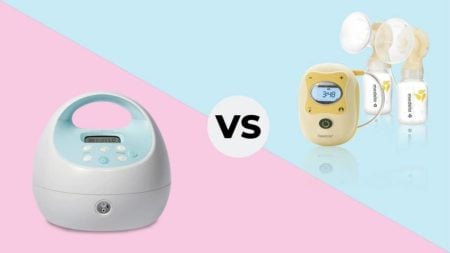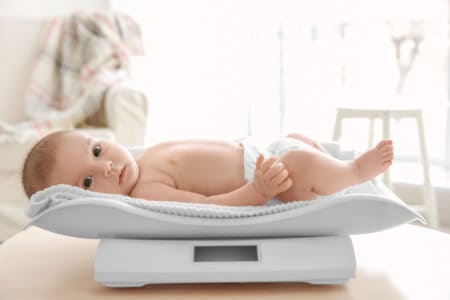One of the most common questions new mothers ask us is how long each breastfeeding session should last.
We all love the snuggle times with our child, but at times, we feel nervous, wondering how to get all our other stuff done with the feeding duty falling on our shoulders, too.
If you’re wondering if your nursing sessions are a reasonable length, we’ll answer that question and more. We’ll also discuss how busy moms can make the most of each breastfeeding session.
Key Takeaways
- Breastfeeding sessions can take between 20 and 45 minutes, and babies usually feed on demand.
- Newborns generally nurse every one to three hours, while older babies feed every four hours.
- A proper latch and good nursing position can help make breastfeeding more comfortable.
- Look for early hunger cues like lip-smacking and fidgeting to know when your baby is ready to nurse.
How Much Milk Do Babies Need?
At birth, babies have tiny stomachs and generally take one to two ounces of milk per feeding. As their stomach (and everything else) begins to grow, they’ll drink more and more.
Most babies will reach peak feeding capacity at five weeks, taking three to four ounces per feeding. After this point, your baby should maintain their intake level until they’re ready for solid foods.
If you’ve formula fed a baby before, that may seem low. Breastfed babies generally take less milk per feeding than formula-fed babies.
How Often Do Babies Feed?
Babies do best when they are fed on demand, setting their own schedules based on when they’re hungry. You’ll want to follow your child’s lead and look for cues they’re ready to nurse.
Every child is different, but there are some general guidelines to give you some idea of what to expect. Newborns generally nurse every one to three hours, about eight to 12 times a day. After your baby grows, they’ll generally feed every four hours until you start weaning (1). However, some babies continue to feed more frequently.
It’s normal for babies to go through periods of cluster feeding — wanting to nurse very frequently over a few hours. Most of the time, a baby will cluster feed before a long stretch of sleep or when they wake up from a longer-than-normal nap.
Growth spurts will also cause your baby to nurse more often for a couple of days, which will naturally boost your milk supply. These tend to happen when your baby is approximately 3 weeks, 6 weeks, 9 weeks, 3 months, 6 months, and 9 months old.
How Long Should a Breastfeeding Session Last?
A single breastfeeding session can take between 20 and 45 minutes, especially during the newborn period. However, each baby is different, and it’s important not to stop them from feeding too early.
Your baby has a great sense of how much milk they need. When they look sleepy or relaxed and have stopped nursing for a few minutes, there’s a good chance they’re full.
Should I Feed My Baby From a Single Breast?
Most babies will nurse from both breasts during a single breastfeeding session. When your baby has finished feeding from one breast, switch them over to the other. They may take it, or they may not. As long as you have not stopped feeding from the first breast prematurely, it is alright if they do not.
Nursing your baby on both sides also benefits you, preventing engorgement and helping to stimulate milk production (2). Babies who are having trouble gaining weight will benefit from being fed from both breasts at every feeding.
Should I Wake My Baby to Breastfeed?
New babies love to sleep. However, is it wise to wake them up when they haven’t nursed for hours?
The answer is yes — if your baby is younger than five weeks old (3). As much as you might be excited for them to sleep, wake them up every two to three hours to nurse. After they pass the four-week mark, let them sleep if they’re growing normally and meeting milestones.
How to Comfortably Breastfeed
Breastfeeding isn’t always easy, especially when you’re starting off and need to nurse often. When settling down for a 45-minute breastfeeding session multiple times a day, you may find yourself growing bored and uncomfortable.
Here are some easy tips for breastfeeding comfortably.
1. A Proper Latch
A good latch is essential for your baby to get the nourishment they need and prevent pain and discomfort for you. When your baby has latched on correctly, they’ll have most or all of your areola and nipple in their mouth.
With a proper latch, you shouldn’t experience any pain, and you’ll hear good swallowing sounds without any clicking.
2. A Good Position
There are different positions to hold your baby in while you nurse. Try out various positions to find one that works for you and your baby. Certain positions may be good for different times of the day.
Some allow you to sit comfortably in public or lounge peacefully in your bed at night. Finding good breastfeeding positions can help both of you feel comfortable.
These are some essentials for a good nursing position:
- Turn your baby’s body fully toward you (with your baby’s ear, shoulder, and hip aligned).
- Hold your baby snug against you with no space between your body and your baby’s body.
- Ensure both you and your baby are well-supported.
3. A Comfortable Chair
A rocker or chair is essential for any nursery. It’s likely to be where you nurse the most, so you’ll want something sturdy and comfortable.
We suggest looking for a chair with plush materials, a lot of space to move about, a place to put your feet up, and the ability to swivel. This allows you access to what you need while providing ultimate comfort.
4. Rest
Whether your breastfeeding session is long or short, you should be able to relax. Not only is this important for you to have a positive experience, but stress can negatively impact your milk production (4).
Try to create a calm and peaceful atmosphere in the places you breastfeed most often. Moms need all the rest they can get. Use the time you breastfeed to bond with your little one and escape the rest of the world.
5. A Cover-Up
If you’re dying to get out of the house, don’t let breastfeeding stop you from having grand adventures. Thanks to many marvelous inventions, you can go about your daily life and breastfeed wherever you go.
There are nursing bras, fabric covers, and even entire dresses and outfits designed specifically with breastfeeding moms in mind. But even without these tools, you can easily dress in two-piece outfits and nurse your baby wherever you happen to be.
How To Tell if Your Baby Is Hungry
Much to your chagrin, your baby will let you know in a loud manner when they’re hungry. You can save your ears some trauma by watching for early signs they’re ready to nurse:
- Smacking or the licking of lips.
- Positioning to nurse or reaching for your breast.
- Fidgeting or squirming.
- Sucking on body parts or objects.
If your baby is crying and hasn’t nursed for some time, it’s a good indicator they might be hungry. Crying is a late sign of hunger and can make latching very difficult. It’s always best to learn your baby’s early hunger cues and feed them sooner rather than later.
FAQs
Your Breastfeeding Experience
Breastfeeding sessions depend on your baby, from how much they need to drink to how long it will take for them to become full. With some patience and persistence, you can create a natural rhythm with your little one.
Think about your own eating habits. Are all your meals evenly spaced around the clock? Do they all take the same amount of time? Your baby will likely feed at uneven intervals for varying amounts of time. Learning to judge when and how long is all part of parenting your new little bundle.
Editor's Note:
Michelle Roth, BA, IBCLC












